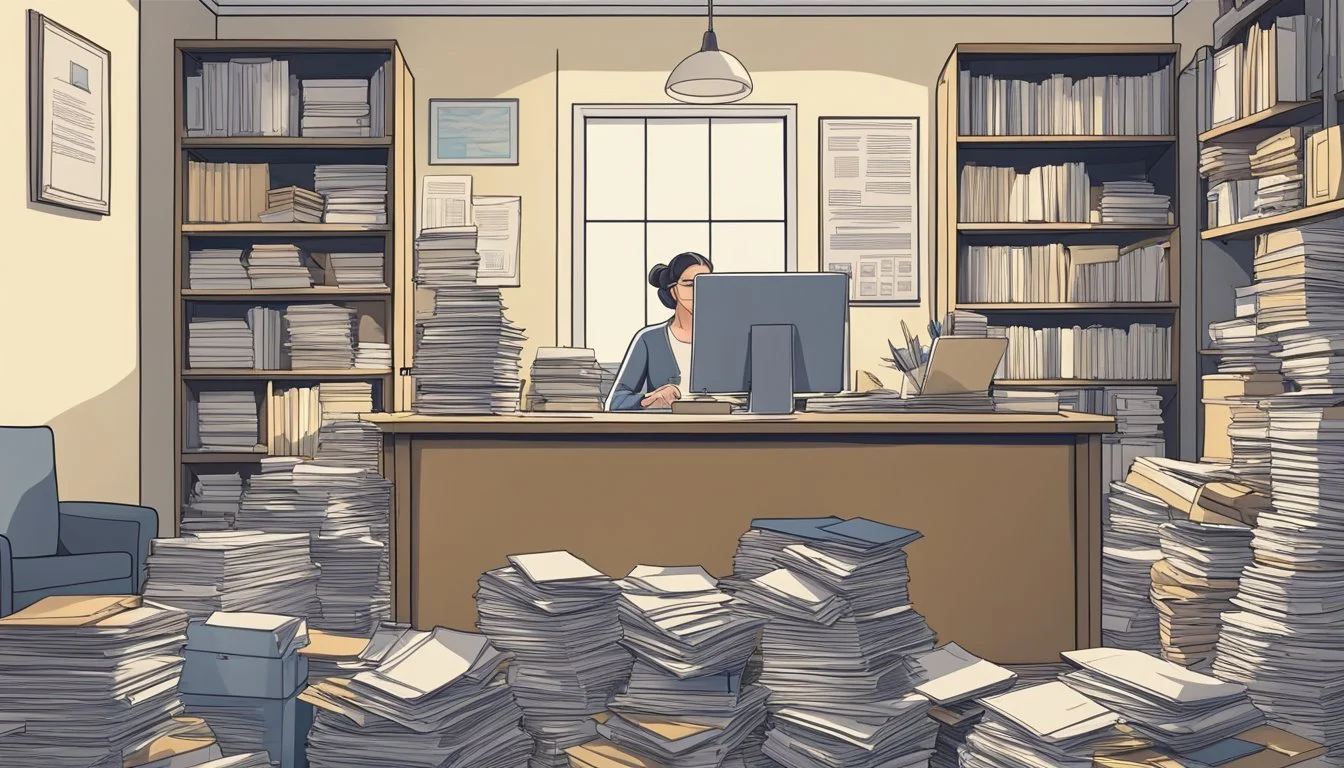Informative Brochures on Hoarding Disorder
Hoarding disorder is a complex mental health condition characterized by difficulty discarding possessions, regardless of their actual value. This results in excessive accumulation of items and clutter that significantly impairs living spaces and daily functioning. Individuals with hoarding disorder experience intense distress when attempting to part with their belongings, leading to unsafe and unsanitary living conditions.
Understanding hoarding disorder is crucial for affected individuals, their loved ones, and healthcare professionals. A well-designed hoarding disorder brochure can serve as a valuable educational tool, providing essential information about the condition's symptoms, diagnosis, and available treatment options. It can also help dispel common misconceptions and reduce stigma surrounding this often misunderstood mental health issue.
Effective hoarding disorder brochures typically include key facts about the condition, its prevalence, and its impact on daily life. They may also offer guidance on seeking help, including resources for professional treatment and support groups. By providing clear, concise information, these brochures can play a vital role in raising awareness and encouraging those affected to seek appropriate care.
Understanding Hoarding Disorder
Hoarding disorder is a complex mental health condition characterized by difficulty discarding possessions and excessive accumulation of items. It can significantly impact a person's quality of life and relationships.
Definition and Diagnosis
Hoarding disorder is recognized in the Diagnostic and Statistical Manual of Mental Disorders (DSM-5) as a distinct mental health condition. It involves persistent difficulty parting with possessions, regardless of their actual value.
The diagnosis requires that the accumulation of items results in living spaces becoming cluttered and unusable. This behavior causes significant distress or impairment in social, occupational, or other important areas of functioning.
Hoarding disorder is separate from other conditions like OCD or depression, though it may co-occur with them.
Symptoms and Behaviors
Key symptoms of hoarding disorder include:
Excessive acquisition of items
Difficulty discarding or parting with possessions
Cluttered living spaces that prevent normal use
Emotional attachment to objects
People with hoarding disorder often experience intense anxiety when trying to discard items. They may believe objects have sentimental value or could be useful in the future.
The accumulation of items can lead to:
Fire hazards
Unsanitary living conditions
Relationship strain
Financial difficulties
Prevalence and Onset
Hoarding disorder affects an estimated 2-6% of the United States population. It typically begins in adolescence or early adulthood, with symptoms gradually worsening over time.
The disorder often becomes more severe in older adults, particularly those over 60 years old. However, it can affect people of all ages.
Hoarding tendencies may intensify during times of stress or major life changes. Early intervention and treatment can help manage symptoms and improve quality of life.
Impact of Hoarding Disorder
Hoarding disorder significantly affects individuals' well-being and strains relationships with family and friends. It creates unsafe living conditions and causes emotional distress for those directly and indirectly involved.
On Individuals
Hoarding disorder impairs daily functioning and quality of life. Accumulated clutter leads to unsafe living conditions, increasing risks of falls and fire hazards. Individuals often experience heightened anxiety and depression related to their possessions and living situation.
Many struggle with intense distress when attempting to discard items. This emotional turmoil can result in social isolation and loneliness. As the clutter grows, basic activities like cooking, cleaning, and sleeping become challenging.
Health issues may arise from unsanitary conditions. The inability to maintain a functional living space can lead to eviction or homelessness in severe cases.
On Families and Relationships
Hoarding behavior strains family dynamics and friendships. Loved ones often feel frustrated and helpless watching the situation deteriorate. Conflicts arise over clutter, safety concerns, and attempts to intervene.
Family members may experience embarrassment, leading to social withdrawal. Children in hoarding households can face neglect and unstable living conditions. This environment may impact their development and future relationships.
Marriages and partnerships suffer as shared spaces become unusable. Resentment builds when one partner's hoarding behavior dominates the home. Family gatherings and social events become difficult or impossible to host.
Interventions by concerned relatives can trigger defensive reactions, damaging trust. Professional help is often necessary to address both the hoarding and its impact on relationships.
Causes and Risk Factors
Hoarding disorder stems from a combination of genetic, psychological, and environmental factors. While the exact causes remain unclear, researchers have identified several key contributors and risk factors.
Genetics and Background
Hoarding tendencies often run in families, suggesting a genetic component. Studies show that individuals with first-degree relatives who hoard are more likely to develop the disorder themselves. Environmental factors during childhood, such as growing up in a cluttered home or experiencing material deprivation, may also play a role.
Family dynamics can influence hoarding behaviors. Some people may learn to hoard as a coping mechanism from family members. Traumatic experiences or significant losses during childhood might contribute to the development of hoarding tendencies later in life.
Psychological Aspects
Cognitive processes and beliefs are central to hoarding disorder. People who hoard often attach excessive emotional value to possessions, viewing items as extensions of themselves or irreplaceable sources of comfort and security. They may struggle with decision-making, fearing they'll make the wrong choice when discarding items.
Anxiety and fear of loss frequently underlie hoarding behaviors. The act of acquiring and keeping items can provide temporary relief from distress. Perfectionism and a need for control may also contribute to hoarding tendencies.
Related Disorders
Hoarding disorder often co-occurs with other mental health conditions. Depression is common among individuals who hoard, potentially both as a cause and consequence of the disorder. Anxiety disorders, particularly generalized anxiety disorder and social anxiety, frequently accompany hoarding behaviors.
Obsessive-compulsive disorder (OCD) shares some similarities with hoarding disorder, though they are distinct conditions. Some individuals with hoarding disorder may also exhibit symptoms of attention deficit hyperactivity disorder (ADHD), which can impact organizational skills and decision-making processes.
Identifying Hoarding Behaviors
Recognizing hoarding disorder involves observing specific patterns of behavior related to acquiring and keeping items. These patterns often interfere with daily life and can lead to unsafe living conditions.
Differentiating Clutter
Hoarding disorder goes beyond typical clutter or messiness. Living spaces become unusable due to excessive accumulation of items. Rooms may be filled with stacks of newspapers, magazines, or other objects, making it difficult to move around or use furniture for its intended purpose.
Key signs include:
Inability to discard items, regardless of value
Severe anxiety when attempting to throw things away
Rooms becoming inaccessible due to clutter
People with hoarding disorder often feel emotionally attached to their possessions, making it challenging to part with even seemingly trivial items.
Excessive Acquisition
Individuals with hoarding disorder frequently engage in excessive buying or acquiring of free items. This behavior is driven by a perceived need to save objects for future use or sentimental reasons.
Common acquisition patterns include:
Compulsively purchasing multiples of the same item
Difficulty passing up free items or sales
Collecting objects others might consider trash
The urge to acquire can be intense, leading to financial strain and overcrowded living spaces. Items may be stockpiled without a clear purpose or plan for use.
Animal Hoarding
Animal hoarding is a specific subtype of hoarding disorder. It involves keeping an unusually large number of pets without providing adequate care. This behavior can result in severe neglect and unsanitary living conditions.
Indicators of animal hoarding:
Accumulating more animals than can be properly cared for
Denial about the animals' health and living conditions
Strong attachment to pets despite obvious problems
Animal hoarders often believe they are rescuing or helping animals, but their inability to provide proper care leads to suffering for both the animals and the hoarder.
Treatment and Management
Effective approaches exist to help individuals manage hoarding disorder. These include specialized therapy, medication options, and building support networks.
Cognitive Behavioral Therapy
Cognitive Behavioral Therapy (CBT) is a primary treatment for hoarding disorder. It focuses on changing thought patterns and behaviors related to acquiring and discarding possessions. A mental health provider guides clients through exposure exercises to practice sorting and discarding items.
CBT also helps develop organizational skills and decision-making abilities. Clients learn to categorize objects and create systems for managing belongings. The therapist may conduct home visits to provide hands-on assistance with decluttering.
Treatment typically lasts several months, with weekly sessions. Many individuals see significant improvements in their living spaces and daily functioning through CBT.
Medication
Some medications may help manage symptoms of hoarding disorder. Selective serotonin reuptake inhibitors (SSRIs) are sometimes prescribed to reduce anxiety and compulsive urges associated with acquiring items.
Paroxetine and venlafaxine extended-release have shown promise in clinical studies. These medications can decrease the emotional attachment to possessions and ease distress when discarding items.
It's important to note that medication is often most effective when combined with therapy. A health care provider can determine if medication is appropriate and monitor its effects.
Support Systems
Building a strong support network is crucial for managing hoarding disorder. Family members and friends can provide encouragement and practical assistance with organizing and decluttering.
Support groups offer a safe space to share experiences and coping strategies. These groups can reduce feelings of isolation and provide motivation for change.
Professional organizers or coaches specializing in hoarding can offer additional guidance. They work alongside mental health providers to implement practical solutions for managing clutter and developing new habits.
Resources and Assistance
Various support options exist for individuals struggling with hoarding disorder and their loved ones. Professional help, organizing services, and community support can provide crucial assistance in managing this condition.
Professional Help
Mental health providers specializing in hoarding disorder offer essential treatment. Cognitive-behavioral therapy (CBT) and other evidence-based approaches can help individuals address underlying issues and develop coping strategies.
The International OCD Foundation (IOCDF) maintains a resource directory of therapists, clinics, and treatment programs. This valuable tool allows people to find local experts in hoarding disorder.
Psychiatrists may prescribe medications to treat co-occurring conditions like depression or anxiety, which often accompany hoarding behaviors.
Organizing and Cleaning Services
Professional organizers and cleaning services can assist with decluttering and creating functional living spaces. These specialists understand the unique challenges of hoarding disorder and approach the process with sensitivity.
Many companies offer hoarding-specific cleanup services. The Hoarding Cleanup website provides a nationwide directory of fee-for-service options.
It's important to involve the individual with hoarding disorder in the organizing process to ensure long-term success and prevent feelings of loss or anxiety.
Community Support
Support groups offer a safe space for individuals with hoarding disorder and their families to share experiences and coping strategies. The IOCDF and local mental health organizations often facilitate these groups.
Community resources like senior centers, social services, and housing authorities may provide additional assistance and referrals.
Online forums and social media groups can offer ongoing support and connection with others facing similar challenges.
Education and awareness programs help reduce stigma and encourage early intervention for hoarding behaviors.





